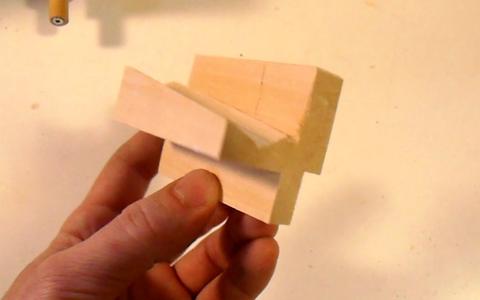Zigzag descent
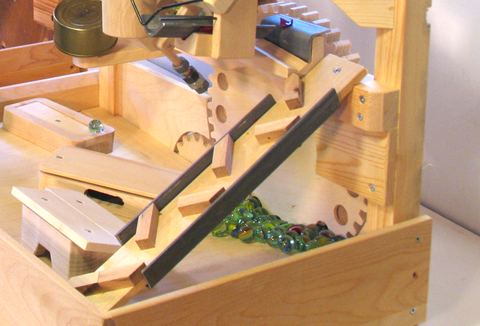 The zigzag descent guides marbles down a zigzag ramp, striking pieces of
angle iron at every turn.
The angle irons are loosely mounted so that they can better ring when struck.
The zigzag descent guides marbles down a zigzag ramp, striking pieces of
angle iron at every turn.
The angle irons are loosely mounted so that they can better ring when struck.
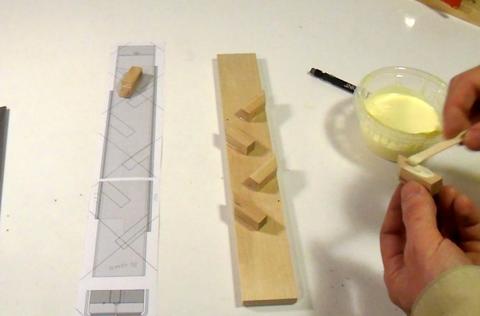 The zigzag consists of a strip of wood with small blocks glued onto it.
Here I'm using my printed out template as a guide for where
to place the blocks. Just holding the template next to the piece and eyeballing it
is sufficiently accurate.
The zigzag consists of a strip of wood with small blocks glued onto it.
Here I'm using my printed out template as a guide for where
to place the blocks. Just holding the template next to the piece and eyeballing it
is sufficiently accurate.
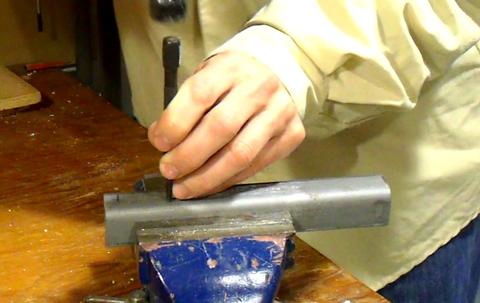 Next I need to prepare the angle iron for mounting. Here I have a piece of angle iron
already cut to length. Before drilling holes in it, I need to make a small divot where
the holes go. Otherwise, the drill will wander before it starts to cut into the metal.
Next I need to prepare the angle iron for mounting. Here I have a piece of angle iron
already cut to length. Before drilling holes in it, I need to make a small divot where
the holes go. Otherwise, the drill will wander before it starts to cut into the metal.
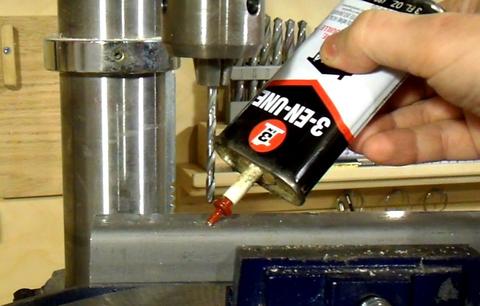 A drop of oil on the hole location and on the drill helps with the cutting.
A drop of oil on the hole location and on the drill helps with the cutting.
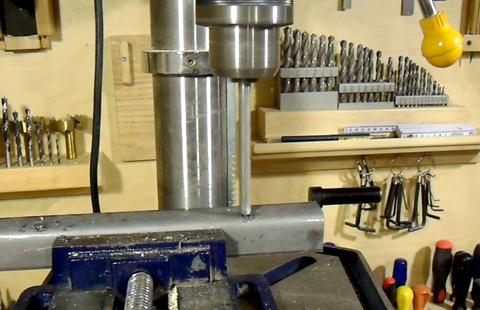 After drilling the holes for the screws, I use the point of a larger drill bit to cut a
countersink around the hole.
After drilling the holes for the screws, I use the point of a larger drill bit to cut a
countersink around the hole.
Do not use a wood countersinking tool for this operation - they are not designed to cut metal.
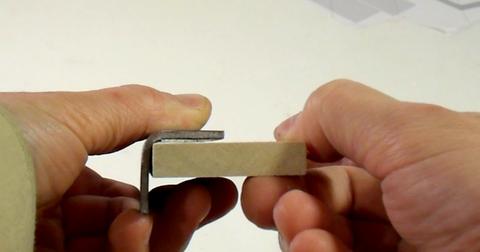 The angle iron will fit on the piece of wood like this. But the angle iron I'm using
doesn't have a sharp corner, so I need to round the edge of the wood to fit.
The angle iron will fit on the piece of wood like this. But the angle iron I'm using
doesn't have a sharp corner, so I need to round the edge of the wood to fit.
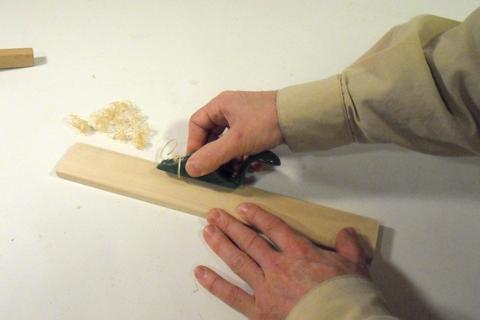 I could use a router to round the edges, but a few strokes with a small hand
plane will do the job too, with no need for setup.
I could use a router to round the edges, but a few strokes with a small hand
plane will do the job too, with no need for setup.
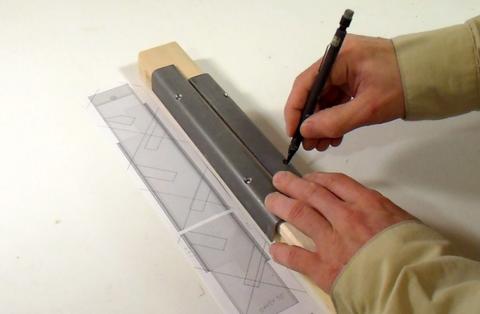 Now placing the angle irons on the back, using the paper template to
guide where to position them. I'm marking the pilot hole
locations through the holes with a pencil.
Now placing the angle irons on the back, using the paper template to
guide where to position them. I'm marking the pilot hole
locations through the holes with a pencil.
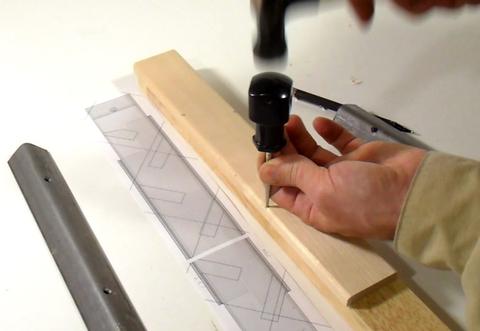 Now making a divot before drilling pilot holes. The holes are very
close to the edge.
Now making a divot before drilling pilot holes. The holes are very
close to the edge.
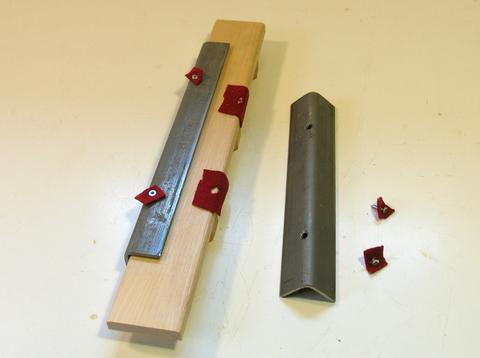 Using pieces of felt (or very soft cloth) to pad between the angle iron and the
wood and screws. The idea is that the angle iron only touches soft felt
so that it can ring better.
Using pieces of felt (or very soft cloth) to pad between the angle iron and the
wood and screws. The idea is that the angle iron only touches soft felt
so that it can ring better.
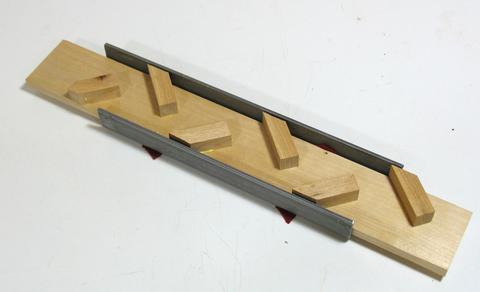 Zigzag ready for some testing. But the angle iron will have to come off again for the
next step.
Zigzag ready for some testing. But the angle iron will have to come off again for the
next step.
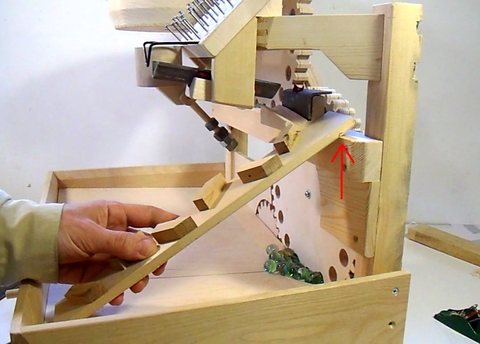 Fitting the ramp, and marking where a notch needs to be cut (see red arrow).
Fitting the ramp, and marking where a notch needs to be cut (see red arrow).
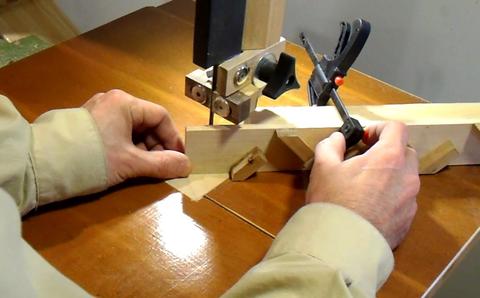 Cutting the notch on the bandsaw. I clamped the zigzag ramp to another block of wood
to help hold it upright as I'm cutting it.
Cutting the notch on the bandsaw. I clamped the zigzag ramp to another block of wood
to help hold it upright as I'm cutting it.
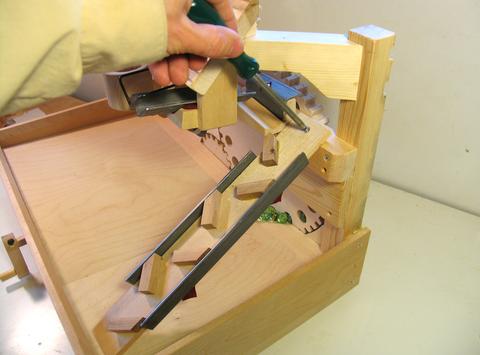 A screw just above the notch holds the rail in place.
A screw just above the notch holds the rail in place.
Deflector ramp
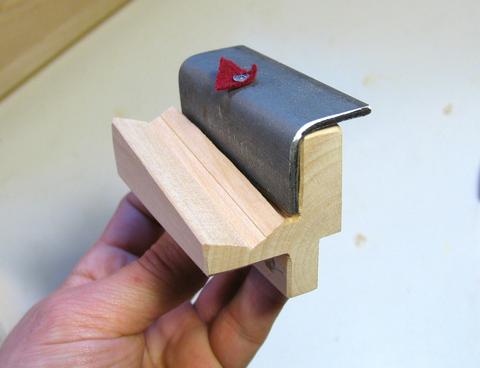 A small ramp is needed to deflect the marbles from the back of the clanking iron
to the zigzag. This deflector ramp has another piece of angle iron for the marbles to
strike and makes a higher pitched "ping" sound.
A small ramp is needed to deflect the marbles from the back of the clanking iron
to the zigzag. This deflector ramp has another piece of angle iron for the marbles to
strike and makes a higher pitched "ping" sound.
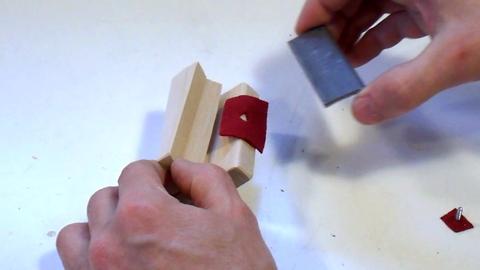 Like the other pieces of angle iron, this one is mounted on a piece of felt so
it can ring more freely.
Like the other pieces of angle iron, this one is mounted on a piece of felt so
it can ring more freely.
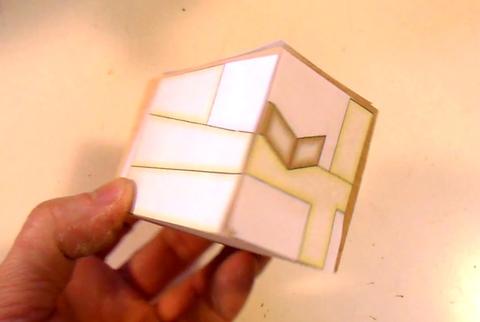 The block that forms the ramp and holds the angle iron is a fairly complex shape.
I'm cutting this whole shape out of a solid block of wood on the bandsaw.
The block that forms the ramp and holds the angle iron is a fairly complex shape.
I'm cutting this whole shape out of a solid block of wood on the bandsaw.
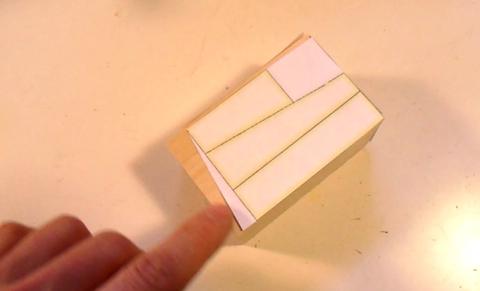 The tricky part will be cutting the angled ramp on this block. To make it easier,
I'm going to make an angled cut in the waste of this block of wood to help support
the block at the right angle.
The tricky part will be cutting the angled ramp on this block. To make it easier,
I'm going to make an angled cut in the waste of this block of wood to help support
the block at the right angle.
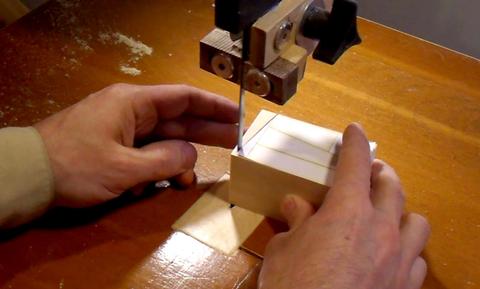 Making that cut, as shown above.
Making that cut, as shown above.
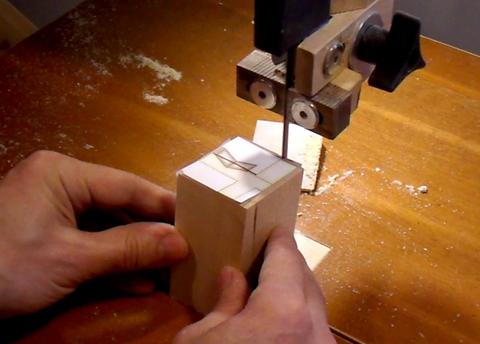 Now here is something I should not have done. I'm starting a cut from the top
of the block. The problem is that the block is already leaning towards the blade,
with no support directly under the block.
Now here is something I should not have done. I'm starting a cut from the top
of the block. The problem is that the block is already leaning towards the blade,
with no support directly under the block.
That sort of cut can be made if the block is held firmly, but I was more focused on making video than on potential hazards!
Fortunately, most mishaps don't lead to injury.
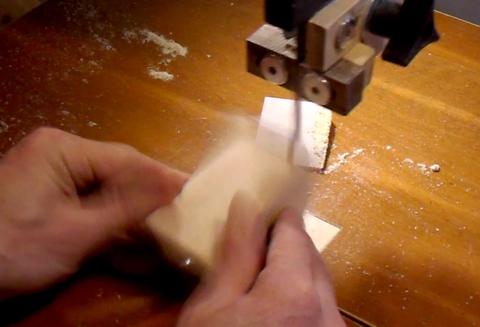 One video frame (33 milliseconds) after the previous image extracted from the video,
and the block got caught by the blade and was thrown forward.
One video frame (33 milliseconds) after the previous image extracted from the video,
and the block got caught by the blade and was thrown forward.
| Got an accident or near-accident story to share? I'm thinking of adding a section about shop accidents. Basically, a different approach to shop safety than the usual "read all the manuals" advice. Reading about actual accidents takes shop safety from the abstract to the practical.
email me at: |
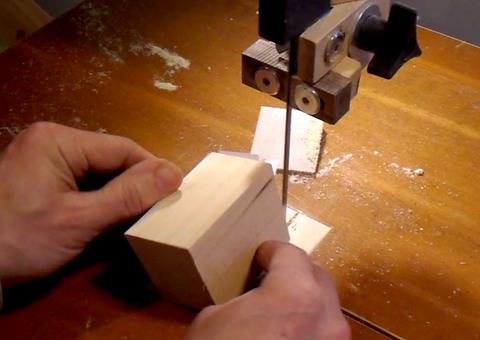 Another 33 milliseconds later and it's all over!
Another 33 milliseconds later and it's all over!
I was startled but unharmed. The work piece only has minor damage, and the blade (thanks to a lot of blade tension) didn't get a kink from this.
Another three frames later (165 milliseconds since before the mishap) and I have pulled my hands away from the saw. I didn't know my reaction time was that good :) . But my reaction time was still more than twice as long as the mishap.
Good thing I was holding the stock in such a way that my fingers couldn't get pulled into the blade.
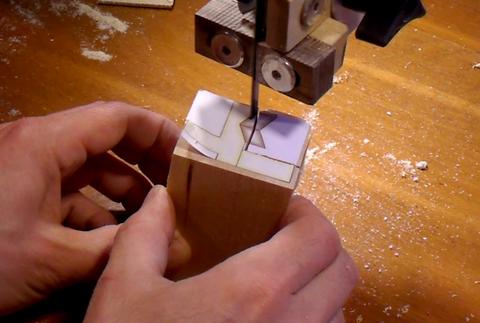 I decided to finish cutting that ramp part by cutting in from the side, not the top.
The side presents a vertical face to the block, whereas the "top" of the block
has that dangerous overhang.
I decided to finish cutting that ramp part by cutting in from the side, not the top.
The side presents a vertical face to the block, whereas the "top" of the block
has that dangerous overhang.
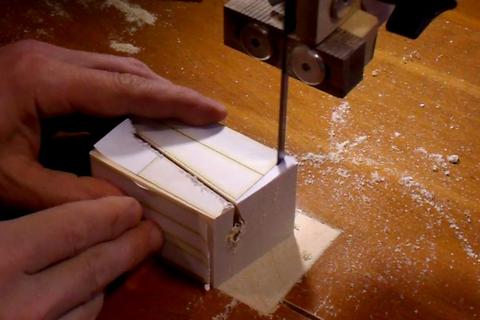 With the angled ramp cut, I can now square off the end of the block,
then make all the straight cuts. With the block squared up, I could safely
finish the cut from the top that had previously kicked the block forward.
With the angled ramp cut, I can now square off the end of the block,
then make all the straight cuts. With the block squared up, I could safely
finish the cut from the top that had previously kicked the block forward.
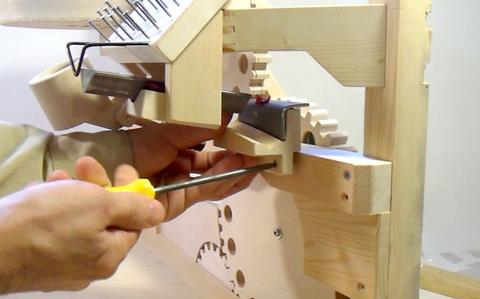 The ramp is mounted with two screws, as shown.
The ramp is mounted with two screws, as shown.
Simplified deflector ramp
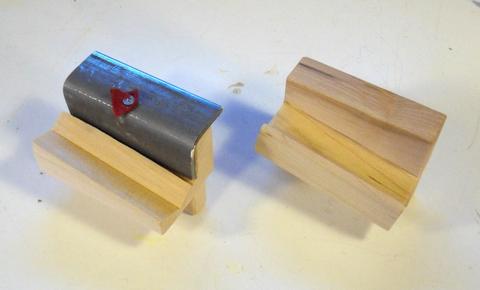 In light of the mishap that I had cutting the complicated ramp shape, and considering that
the "ping" the angle iron makes can hardly be heard over the rest of the cacophony
of the machine, I figured I'd experiment with a simpler, easier-to-make deflector
ramp. The original ramp is at left, the simplified ramp is at right.
In light of the mishap that I had cutting the complicated ramp shape, and considering that
the "ping" the angle iron makes can hardly be heard over the rest of the cacophony
of the machine, I figured I'd experiment with a simpler, easier-to-make deflector
ramp. The original ramp is at left, the simplified ramp is at right.
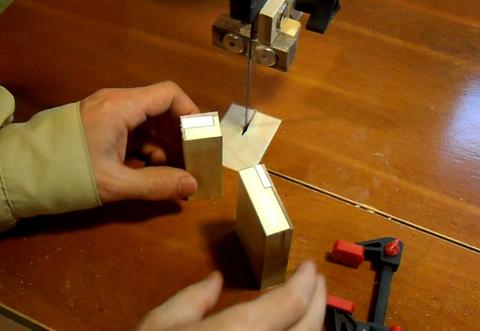 Unlike my other ramp, this ramp is made out of two pieces. That saves the trouble of making
complicated angled cuts.
Unlike my other ramp, this ramp is made out of two pieces. That saves the trouble of making
complicated angled cuts.
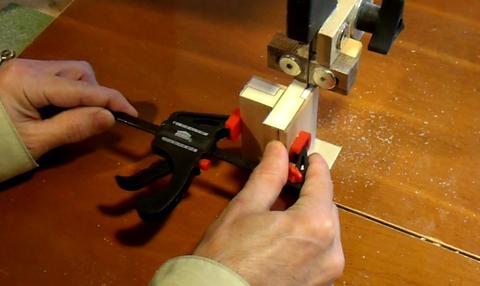 The notches could be cut on a table saw, but clamping the two pieces together (for more support),
it's pretty quick and easy to cut those notches on the bandsaw. The pieces are only
7 cm long (less than 3"), so it's pretty easy to cut them standing upright on the bandsaw.
The notches could be cut on a table saw, but clamping the two pieces together (for more support),
it's pretty quick and easy to cut those notches on the bandsaw. The pieces are only
7 cm long (less than 3"), so it's pretty easy to cut them standing upright on the bandsaw.
Many bandsaws only have a plastic insert which doesn't provide very good support near the blade. If your bandsaw is one of those, consider clamping a piece of plywood on the bandsaw table
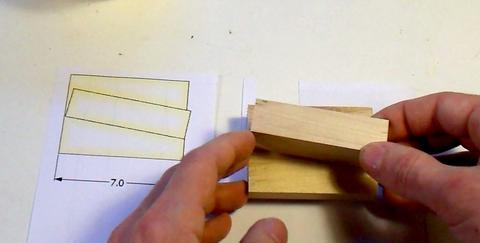 Now gluing the ramp on at an angle. I'm just eyeballing the position, using a 1:1 printout
from the plans as a guide.
Now gluing the ramp on at an angle. I'm just eyeballing the position, using a 1:1 printout
from the plans as a guide.
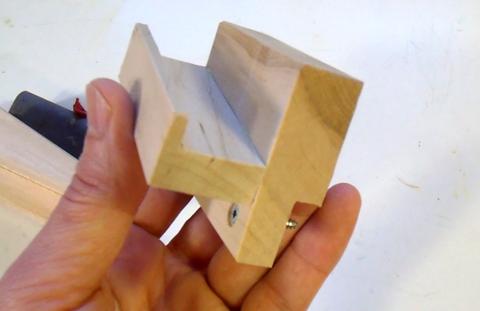 The angled ramp. Simple and easy to make.
The angled ramp. Simple and easy to make.
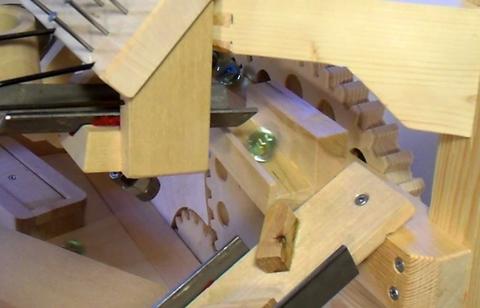 Mounted in place and testing it. It makes a nice clacking sound. I should have just
started with this design.
Mounted in place and testing it. It makes a nice clacking sound. I should have just
started with this design.
Next:Below the bowl ramps
Back to Marble machine 2.1

